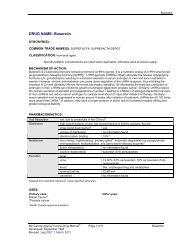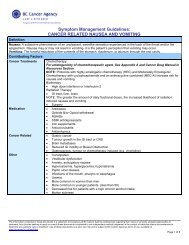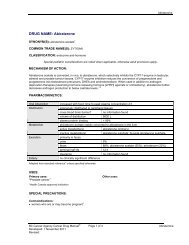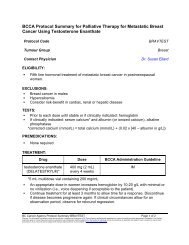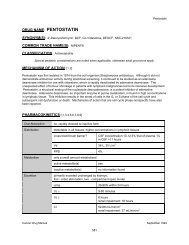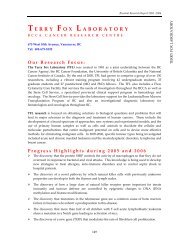BCCA Protocol Summary for Palliative Therapy for Metastatic Breast ...
BCCA Protocol Summary for Palliative Therapy for Metastatic Breast ...
BCCA Protocol Summary for Palliative Therapy for Metastatic Breast ...
Create successful ePaper yourself
Turn your PDF publications into a flip-book with our unique Google optimized e-Paper software.
<strong>BCCA</strong> <strong>Protocol</strong> <strong>Summary</strong> <strong>for</strong> <strong>Palliative</strong> <strong>Therapy</strong> <strong>for</strong> <strong>Metastatic</strong> <strong>Breast</strong><br />
Cancer using Trastuzumab (Herceptin®) and Paclitaxel as First-Line<br />
Treatment <strong>for</strong> Recurrent <strong>Breast</strong> Cancer<br />
<strong>Protocol</strong> Code:<br />
BRAVTRAP<br />
Tumour Group:<br />
Contact Physician:<br />
<strong>Breast</strong><br />
Dr. Karen Gelmon<br />
ELIGIBILITY:<br />
• Overexpression of HER-2 neu (+3 over-expression by IHC, OR +2 overexpression<br />
by IHC only if confirmed by FISH)<br />
• Patient ineligible <strong>for</strong>, or unwilling to participate in, a clinical trial<br />
• Life expectancy > 3 months<br />
• ECOG status 0-2<br />
• No signs or symptoms of cardiac disease. For patients with equivocal cardiac status,<br />
a MUGA scan or ECHO should be done and reveal a normal left ventricular ejection<br />
fraction.<br />
• A “Class II Drug Registration Form” must be submitted <strong>for</strong> Trastuzumab at the time of<br />
initiation of treatment.<br />
EXCLUSIONS:<br />
• Clinically significant cardiac disease (history of symptomatic ventricular arrhythmias,<br />
congestive heart failure or myocardial infarction within previous 12 months)<br />
TESTS:<br />
• Baseline: CBC & diff, platelets, total bilirubin, AST<br />
• Baseline if clinically indicated: cardiac function (ECG, echocardiogram or MUGA scan)<br />
• Be<strong>for</strong>e each paclitaxel treatment: CBC & diff, platelets<br />
• If clinically indicated be<strong>for</strong>e each paclitaxel treatment: total bilirubin, AST<br />
• If clinically indicated at any time: cardiac function<br />
PREMEDICATIONS:<br />
• Not usually required <strong>for</strong> trastuzumab<br />
• Paclitaxel must not be started unless the following drugs have been given:<br />
45 minutes prior to Paclitaxel:<br />
• Dexamethasone 20 mg IV in 50 mL NS over 15 minutes<br />
30 minutes prior to Paclitaxel:<br />
• Diphenhydramine 50 mg IV and Ranitidine 50 mg IV in 50 mL NS over 20<br />
minutes (compatible up to 3 hours when mixed in bag)<br />
• Additional antiemetics not usually required.<br />
B.C. Cancer Agency <strong>Protocol</strong> <strong>Summary</strong> BRAVTRAP 1 of 6
TREATMENT:<br />
Cycle 1 2 3<br />
Week 1 1 2 3 4 5 6 7 8 9<br />
Day 1 2 8 15 1 8 15 1 8 15 etc<br />
Trastuzumab X X X<br />
Paclitaxel X X X<br />
Paclitaxel is given on day 2 <strong>for</strong> cycle 1 only. In subsequent cycles,<br />
paclitaxel is given after trastuzumab on day 1.<br />
Repeat every 21 days x 6 cycles. Discontinue if no response after 2 cycles.<br />
Note: To continue single agent trastuzumab after completion of cycle 6, see<br />
protocol BRAVTR.<br />
Cycle 1<br />
Day 1<br />
Drug Dose <strong>BCCA</strong> Administration Guideline<br />
Trastuzumab (Herceptin®)<br />
8 mg/kg<br />
Day 1 only<br />
IV in 250 mL NS over 90 minutes<br />
Observe <strong>for</strong> 60 minutes post-infusion**<br />
Day 2<br />
Drug Dose <strong>BCCA</strong> Administration Guideline<br />
Paclitaxel 175 mg/m 2<br />
IV in 500 mL* NS over 3 hours<br />
Day 2 only (use non-PVC equipment, in-line filter)<br />
*use 250 mL <strong>for</strong> doses less than 150 mg<br />
B.C. Cancer Agency <strong>Protocol</strong> <strong>Summary</strong> BRAVTRAP 2 of 6
Cycles 2 - 6<br />
Day 1<br />
Drug Dose <strong>BCCA</strong> Administration Guideline<br />
Trastuzumab (Herceptin®) 6 mg/kg IV in 250 mL NS over 90 minutes,<br />
Observe <strong>for</strong> 30 minutes post-infusion**,<br />
then start Paclitaxel premedications<br />
Paclitaxel 175 mg/m 2 IV in 500 mL* NS over 3 hours<br />
(use non-PVC equipment, in-line filter)<br />
*use 250 mL <strong>for</strong> doses less than 150 mg<br />
**observation period not required after 3 consecutive treatments with no reaction<br />
DOSE MODIFICATIONS:<br />
1. Trastuzumab:<br />
None required. Discontinue if unacceptable toxicity occurs.<br />
2. Paclitaxel:<br />
2a. Hematological<br />
ANC (x 10 9 /L) Platelets (x 10 9 /L) Dose Dose after neutropenic<br />
sepsis on Paclitaxel<br />
≥ 1.5 and > 90 175 mg/m 2 135 mg/m 2<br />
1.0 - 1.4 or 70-90 135 mg/m 2 135 mg/m 2<br />
< 1.0 or < 70 delay delay<br />
2b. Hepatic Dysfunction<br />
Bilirubin (µmol/L) AST Dose<br />
≤25 and < 2 x ULN 175 mg/m 2<br />
≤25 and ≥ 2 x ULN with no liver metastases or<br />
135 mg/m 2<br />
≥ 5 x ULN with liver metastases<br />
25-50 75 mg/m 2<br />
>50 50 mg/m 2<br />
ULN = upper limit of normal<br />
2c. Neuropathy: Dose modification or discontinuation may be required (see <strong>BCCA</strong><br />
Cancer Drug Manual).<br />
2d. Arthralgia and/or myalgia: If arthralgia and/or myalgia of grade 2 (moderate) or<br />
higher is not relieved by adequate doses of NSAIDs or acetaminophen with codeine<br />
B.C. Cancer Agency <strong>Protocol</strong> <strong>Summary</strong> BRAVTRAP 3 of 6
(e.g., Tylenol #3®), a limited number of studies report a possible therapeutic benefit<br />
using:<br />
• Prednisone 10 mg po bid x 5 days starting 24 hours post-paclitaxel<br />
• Gabapentin 300 mg po on day be<strong>for</strong>e chemotherapy, 300 mg bid on treatment<br />
day, then 300 mg tid x 7-10 days<br />
If arthralgia and/or myalgia persist, reduce subsequent Paclitaxel doses to 135<br />
mg/m 2 .<br />
PRECAUTIONS:<br />
1. Cardiac toxicity: Trastuzumab can produce ventricular dysfunction and congestive<br />
heart failure in about 2-4% of patients. The majority of patients who develop cardiac<br />
dysfunction are symptomatic. Regular monitoring of asymptomatic patients is not<br />
routinely necessary but may be ordered within 4-6 months of treatment with<br />
trastuzumab. If no significant decline in cardiac function is apparent, repeated<br />
testing is not generally necessary, unless the patient’s medical condition changes.<br />
Discontinue treatment <strong>for</strong> symptomatic congestive heart failure or serious cardiac<br />
arrhythmias. Most patients who develop cardiac dysfunction respond to appropriate<br />
medical therapy and in some cases (where the benefit outweighs the risk) may<br />
continue trastuzumab under close medical supervision.<br />
2. Trastuzumab infusion-associated symptoms, usually chills and fever, occur in<br />
40% of patients during the first trastuzumab infusion (infrequent with subsequent<br />
infusions). Other signs and symptoms may include nausea, vomiting, pain<br />
(sometimes at tumour sites), rigors, headache, dizziness, dyspnea, hypotension,<br />
rash and asthenia. Symptoms may be treated with acetaminophen,<br />
diphenhydramine and meperidine with or without an infusion rate reduction.<br />
Rarely, serious infusion-related reactions have been reported (3 per 1000<br />
patients) sometimes leading to death (4 per 10,000). Reactions include dyspnea,<br />
hypotension, wheezing, bronchospasm, tachycardia, reduced oxygen saturation and<br />
respiratory distress, and, uncommonly, allergic-like reactions. Patients experiencing<br />
dyspnea at rest due to pulmonary metastases and other pulmonary/cardiac<br />
conditions may be at increased risk of a fatal infusion reaction and should be treated<br />
with extreme caution, if at all. For serious reactions, discontinue the trastuzumab<br />
infusion and provide supportive therapy such as oxygen, beta-agonists and<br />
corticosteroids.<br />
3. Neutropenia: Fever or other evidence of infection must be assessed promptly and<br />
treated aggressively.<br />
B.C. Cancer Agency <strong>Protocol</strong> <strong>Summary</strong> BRAVTRAP 4 of 6
4. Hypersensitivity: Reactions are common with paclitaxel. See <strong>BCCA</strong><br />
Hypersensitivity Guidelines.<br />
Mild symptoms (e.g. mild flushing, rash,<br />
pruritus)<br />
• complete Paclitaxel infusion.<br />
Supervise at bedside<br />
• no treatment required<br />
moderate symptoms (e.g. moderate rash,<br />
flushing, mild dyspnea, chest discom<strong>for</strong>t,<br />
mild hypotension<br />
• stop Paclitaxel infusion<br />
• give IV Diphenhydramine 25-50 mg<br />
and Hydrocortisone IV 100 mg<br />
• after recovery of symptoms resume<br />
Paclitaxel infusion at 20 mL/h <strong>for</strong> 5<br />
minutes, 30 mL/h <strong>for</strong> 5 minutes, 40<br />
mL/h <strong>for</strong> 5 minutes, then 60 mL/h <strong>for</strong> 5<br />
minutes. If no reaction, increase to full<br />
rate.<br />
• if reaction recurs, discontinue<br />
Paclitaxel therapy<br />
severe symptoms (i.e. one or more of<br />
respiratory distress requiring treatment,<br />
generalised urticaria, angioedema,<br />
hypotension requiring therapy)<br />
• stop Paclitaxel infusion<br />
• give IV antihistamine and steroid as<br />
above. Add Epinephrine or<br />
bronchodilators if indicated<br />
• discontinue Paclitaxel therapy<br />
5. Extravasation: Paclitaxel causes pain and tissue necrosis if extravasated. Refer to<br />
<strong>BCCA</strong> Extravasation Guidelines.<br />
6. A possible interaction with warfarin has been reported. An increased INR and<br />
bleeding may occur in patients previously stabilized on warfarin. The interaction was<br />
noted in two patients after 8-10 doses of trastuzumab. An INR prior to starting the<br />
trastuzumab is recommended, then weekly <strong>for</strong> the first 3 months and then monthly if<br />
stable. In<strong>for</strong>m patient to watch <strong>for</strong> any bleeding. Modification of the warfarin dose<br />
may be needed. (JAMA 1999;282:2299-301)<br />
B.C. Cancer Agency <strong>Protocol</strong> <strong>Summary</strong> BRAVTRAP 5 of 6
Call Dr. Karen Gelmon or tumour group delegate @ (604) 877-6000 or 1-800-663-<br />
3333 with any problems or questions regarding this treatment program.<br />
Date activated: 01 Nov 1999<br />
Date last revised: 1 Sep 2005 (revise trastuzumab observation period)<br />
References:<br />
1. Slamon D, Leyland-Jones B, Shak S, Paton V et al. Addition of Herceptin<br />
(humanized anti-HER2 antibody) to first line chemotherapy <strong>for</strong> HER2 overexpressing<br />
metastatic breast cancer (HER2 +/MBC) markedly increases anticancer activity: a<br />
randomized, multinational controlled phase III trial. Proc Am Soc Clin Oncol<br />
1998;17:98a.<br />
2. Gelmon K, Arnold A, Verma S et al. Pharmacokinetics (PK) and safety of<br />
trastuzumab (Herceptin®) when administered every three weeks to women with<br />
metastatic breast cancer. [Abstract 271] Proc Am Soc Clin Oncol 2001;20(1):69a.<br />
3. Perez A, Rodeheffer R. Clinical Cardiac Tolerability of Trastuzumab. J Clin Oncol<br />
2004;22:322-329.<br />
B.C. Cancer Agency <strong>Protocol</strong> <strong>Summary</strong> BRAVTRAP 6 of 6




